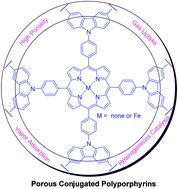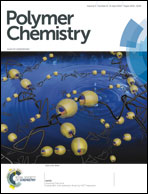Adsorption performance and catalytic activity of porous conjugated polyporphyrins via carbazole-based oxidative coupling polymerization†
Abstract
Carbazole-based oxidative coupling polymerization is an efficient method to prepare various porous polycarbazoles without requirement of any specific functional groups for coupling polymerization. Herein, facile preparation of porous conjugated polymers (CPOP-11 and CPOP-12) using porphyrin or Fe(II)–porphyrin as core structures through this approach is reported. The Brunauer–Emmett–Teller specific surface area of the obtained polymers is up to 1320 m2 g−1, which is comparable to metalloporphyrin based porous polymers prepared by other coupling polymerization methods. It is worth noting that the adsorption amount of toluene by CPOP-12 is high up to 1192 mg g−1 (about 13.0 mmol g−1) at its saturated vapor pressure, which would be very promising to eliminate harmful small aromatic molecules in the environment. As a kind of hydrophobic material, CPOP-11 could be more useful to extract methanol from water due to its high mass ratio of adsorbed methanol to water. Meanwhile, a porous polymer containing Fe(II)–porphyrin (CPOP-12) is also an effective catalyst for the formation of glycosyl sulfoxides from sulfides by promoting the transfer of oxygen atoms and can be reused without significant decrease in catalytic activity and amount of catalyst.


 Please wait while we load your content...
Please wait while we load your content...